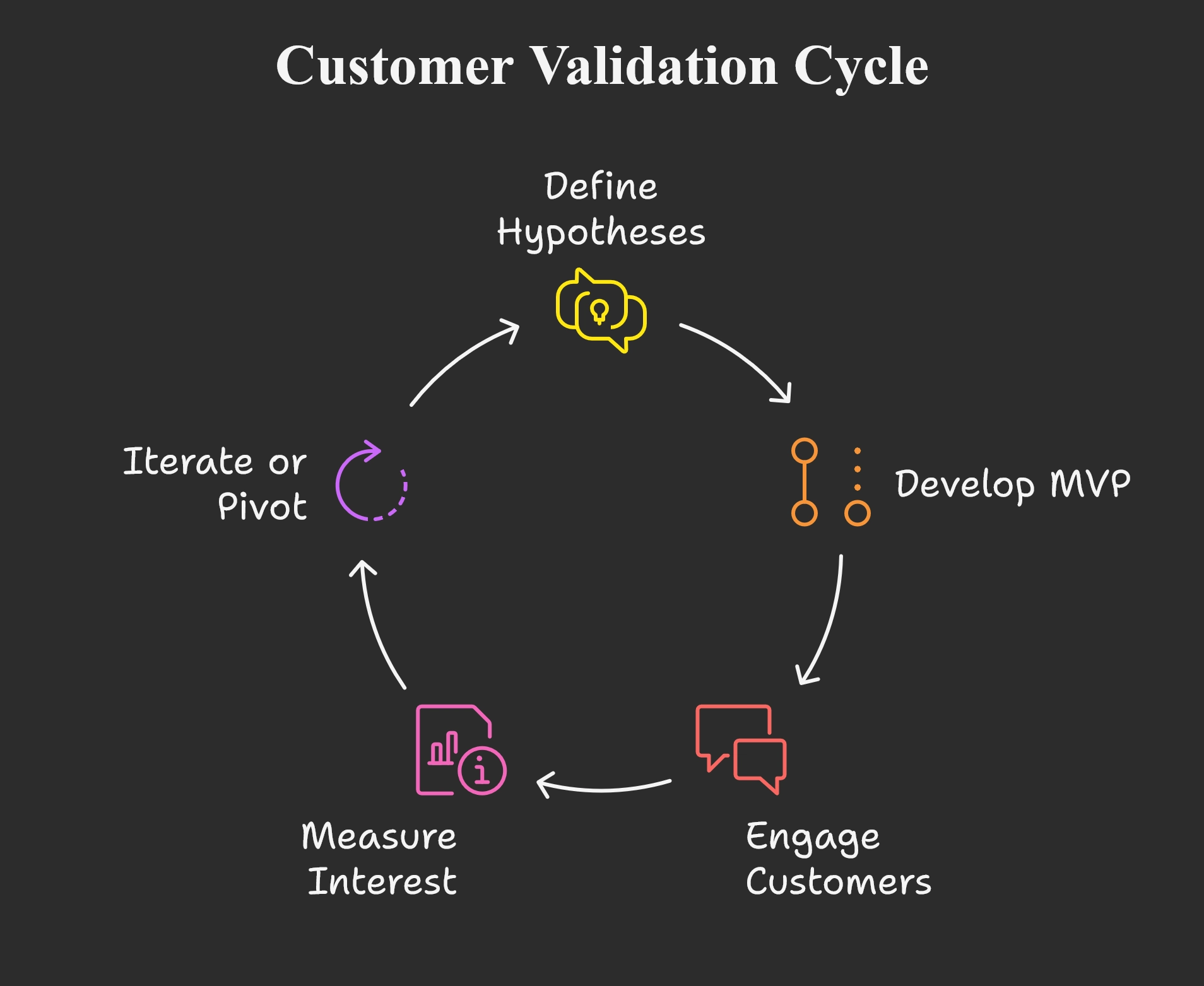Customer Validation: Testing Your Startup’s Idea with Real Customers

Customer validation is the process of testing your product idea with real people to confirm it solves a genuine problem and that customers are willing to pay for it. Early-stage founders and product managers search for customer validation when they want to check their assumptions – for example, “Do people actually need this? Will they buy it?” Customer validation helps you turn guesses into evidence. It ensures you’re building something customers want and reduces the chance of launching a product nobody will use. In practical terms, customer validation involves interviewing potential users, running quick experiments (like landing pages or prototypes), and iterating on your idea based on real feedback.
People look up customer validation to reduce risk and find product-market fit. Without it, “untested assumptions can easily lead to failure.” In other words, skipping validation often wastes time and money on a product nobody needs. Customer validation “helps you ensure you build something people will buy.” By gathering evidence early, you avoid building features in the dark and make data-driven decisions. Validation is the “easiest and lowest-cost way to reduce risk” for new products.
-
Reduce risk: Test your assumptions before heavy investment.
-
Save time and money: Avoid building features or marketing efforts nobody needs.
-
Find product-market fit: Confirm that your solution truly solves a real customer problem.
-
Gain confidence: Real feedback (signups, pre-orders, surveys) provides evidence investors and teams can trust.
Diagram: Customer discovery and validation turn assumptions into a validated business model. Start by writing down your assumptions about the market and customers. Then use customer discovery (interviews and research) and validation (MVP tests and surveys) to refine your approach. You begin with an assumption about your business model, run discovery and validation steps, and end up with a validated model. This cycle of testing and learning turns uncertain hypotheses into real insights.
Customer Discovery vs. Customer Validation
Customer discovery and customer validation are two sides of the same coin. Discovery comes first: you’re trying to understand the customer and the problem. This means asking open-ended questions like “Who are our customers?” and “What problems do they face?” In discovery you dig deep into customer needs and market conditions. In contrast, validation comes next: you’re testing whether your solution solves that problem and whether customers are willing to pay for it. In validation you might show people a prototype or landing page and ask “Does this solve your problem? Would you buy it?”
| Customer Discovery | Customer Validation |
|---|---|
| Identifying real customer problems and needs | Testing proposed solutions with real customers |
| Understanding customer who and why | Measuring if customers care and will pay |
| Research with interviews, surveys | Using MVPs, demos, or trials to gather feedback |
| Hypothesis phase (“We think customers do X”) | Hypothesis testing phase (“Customers buy at $Y?”) |
Chart: Customer development model (discovery → validation → creation). These phases often overlap. You may uncover a new insight during validation that sends you back to discovery (pivoting your idea). This back-and-forth is part of refining your product. Once you’ve proven real demand through discovery and validation, you move to “customer creation” – scaling up your marketing and growth.
The Customer Validation Process

A typical customer validation process follows a structured series of steps:
1. Define Your Hypotheses. Write down your key assumptions about the market, customers, and problems you intend to solve. For example: “Our target users are [X people] with this problem.”
2. Develop an MVP or Prototype. Create the simplest version of your product that can test your core assumptions. This could be a basic prototype, a mockup, or even a video demo. The goal is just to have something tangible to show customers.
3. Engage Potential Customers. Reach out to real prospects and ask for feedback. Use methods like interviews, focus groups, or surveys. Ask open questions (“Tell me about the last time…”, “How do you currently solve X?”) to avoid leading them. Record what they say and watch their reactions carefully.
4. Measure Interest and Willingness to Pay. Launch quick tests to see if people take action. For example, run a landing page where visitors can sign up or pre-order. Track metrics like click-through rates, sign-ups, or actual purchase commitments. These concrete signals (not just positive comments) show real demand.
5. Iterate or Pivot. Analyze the feedback and data. If customers are enthusiastic and sign up, you’re on the right track. If not, use the insights to refine your idea: change features, adjust pricing, or even target a different customer segment. Repeat the validation loop until customers validate the product-market fit.
Common customer validation techniques include:
-
One-on-one interviews: Talk directly with target users to uncover their needs and pain points. Ask them to walk you through their workflow or problems.
-
Surveys and questionnaires: Gather broader feedback by asking targeted questions. Use incentives to encourage honest responses.
-
Prototypes or MVPs: Show customers a simple product or prototype. Demonstrate a mockup or video and gauge reactions.
-
Landing pages: Create a webpage describing your product and offer a “sign up” or “join waiting list” button. See how many people register.
-
Pilot tests / Concierge: Offer a manual or limited version of the service. For example, Zappos’ founder started by listing real store shoes online and buying them one-by-one as orders came in. This proved demand without building inventory.
Each technique should be chosen to test specific questions, such as “Will customers pay $X for this?” or “Which features matter most?”. The key is to learn quickly. “Don’t listen to your friends or family – they aren’t your target market.” Focus on real potential customers and measurable actions (like sign-ups or purchases).
Real-World Examples of Customer Validation
-
Dropbox (File Sharing App): Before writing a single line of code, Dropbox’s founders made a short demo video explaining the product. They shared it online and the video went viral, generating thousands of email sign-ups. This validated that people wanted a simple way to sync files, giving the team confidence to build the actual product.
-
Zappos (Online Shoes Retailer): Zappos’ founder wanted to test demand for online shoe sales without investing in inventory. He took photos of shoes in local stores and posted them on a website. When customers ordered, he bought the shoes from the store and shipped them himself. This scrappy test proved people would buy shoes online and paid enough, paving the way to build the full Zappos business.
-
Airbnb (Home Rental Platform): Early Airbnb founders needed to know if travelers would rent someone’s home. To validate, they rented out their own apartment to conference attendees and personally met each guest. This hands-on experiment confirmed interest and provided invaluable feedback on what hosts and guests actually needed, shaping the platform’s features.
These examples share a theme: validate the market before you build. In each case, a simple experiment gave clear evidence of real user interest, saving time and guiding the next steps.
GrowthJockey’s AI-Driven Approach for Customer Validation
For startups that need a structured path from idea to launch, GrowthJockey - A Venture Builder offers a unique blend of venture architecture and AI-driven validation. As venture architects, their team helps founders design business models and roadmaps that are both scalable and customer-focused.
Using AI analytics and machine learning tools, GrowthJockey accelerates the validation process: for example, by analyzing market trends or even running algorithmic tests on pricing and messaging. Their end-to-end methodology covers ideation, prototyping, customer validation, product-market fit, and go-to-market execution. In practice, GrowthJockey guides you through each phase with data-driven insights and expert coaching. The result is that startups can iterate faster, avoid common pitfalls, and move more confidently toward a sustainable, scalable business.
Frequently Asked Questions
Q1. What do you mean by customer validation?
Customer validation means verifying that your product idea solves a real problem for a real customer and that they’re willing to pay for it. It involves talking to potential users, showing them prototypes or descriptions of your product, and collecting feedback. In essence, it’s testing your core hypothesis with the market before building a full solution.
Q2. What are the 5 steps of validation?
While processes can vary, a common five-step validation approach is:
-
Define hypotheses: Specify what problems you think exist and who your customers are.
-
Build an MVP or prototype: Create the simplest version of your solution that can test those hypotheses.
-
Engage customers: Conduct interviews or surveys and show the MVP to real target users.
-
Measure interest: Use landing pages, sign-ups, pre-orders or pilot tests to see if customers take action (e.g., join a waiting list).
-
Iterate or pivot: Use the insights to improve your idea or change course, then repeat the process.
Q3. What is the customer validation strategy?
A customer validation strategy is a plan for how you will test all key assumptions about your product and market. It means using a combination of techniques (interviews, prototypes, surveys, landing pages, etc.) to gather real-world evidence. The strategy focuses on quick, low-cost experiments that prove whether customers truly care about your solution. The goal is to validate (or invalidate) each major hypothesis step by step, so decisions are data-driven and based on actual customer feedback.
Q4. What is client validation?
“Client validation” is essentially the same concept as customer validation. The term client is often used in B2B or service contexts, but the idea is identical: you validate with the paying party that your solution meets their needs. Whether you say “customer” or “client,” you’re still collecting feedback from real end-users (or buyers) to confirm your solution is on target.








